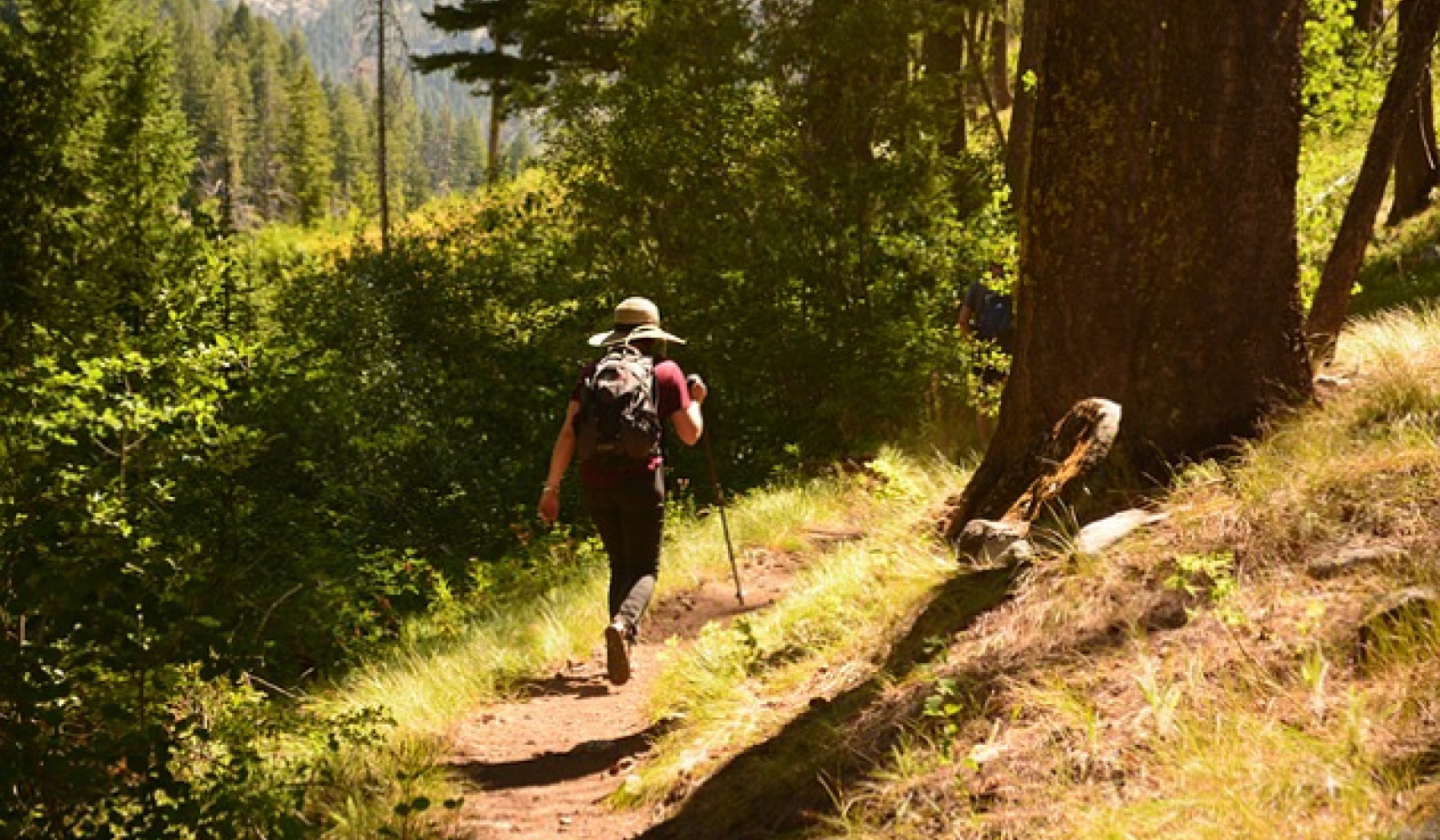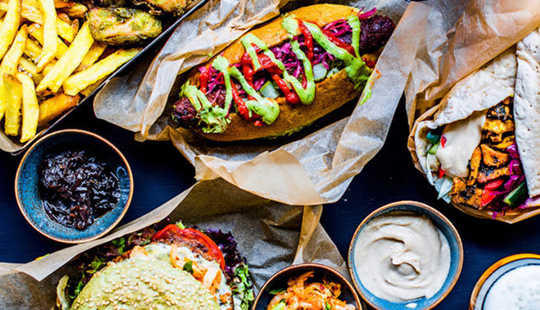 Photo courtesy of Mark Kulsdom
Photo courtesy of Mark Kulsdom
Despite its environmental benefits, using local seaweed for food can be a tough sell. Some think the Dutch have finally cracked the code.
“Is seaweed a vegetable?” a wide-eyed child asks a tall man chopping kelp at a “Taste the Nature” market in the Zuiderpark city farm in The Hague.
“Well, it has lots of vitamins and minerals,” the cook, Jethro van Luijk, replies.
“It does look like spinach,” says the child thoughtfully. But, unconvinced this plant is truly edible, he bounces away to other stalls displaying other wonders like organic snails and mushrooms grown from coffee grounds.
Under his pseudonym The Green Chef, Van Luijk is at the market to promote seaweed as the food of the future. He says along with the vitamins and minerals, seaweed is also full of protein, and cultivation requires no arable land, no fertilizer and no freshwater. And by growing it locally, he says, the Netherlands could wield a sustainable food source that has the added benefit of cleansing the seawater along the Dutch coast.
For today’s event he has teamed up with The North Sea Farm Foundation, which owns an experimental seaweed farm 15 kilometers (9 miles) out to sea from The Hague. He is here to help with a big problem: There’s not a big enough demand for Dutch seaweed to make growing it worthwhile.
Or is there?
Even though the North Sea Farm Foundation is still in the experimental stage — and even though a 2016 report found seaweed farming in the North Sea unlikely to turn a profit — two Dutch companies, Seamore and Zeewaar, have been slipping their seaweed into some of the country’s largest restaurant franchises and supermarkets. Combining clever marketing with environmental stewardship, they may have found the philosopher’s stone to a locally grown seaweed market eluding European and North American producers for decades.
Food of the Future
As he chops mushrooms and carrots for his kelp stew, van Luijk says that seaweed is a newcomer to Dutch cuisine.
“In Asia, eating seaweed is a very old tradition, and also in places that have a rocky coastline, like Norway and Scotland,” he says. “In the Netherlands, though, we’re in a delta. There are no rocks, so seaweed has nowhere to grow.”
He has hope, however, that large-scale cultivation will put Dutch seaweed on the menus of tomorrow. To this same end The North Sea Farm Foundation in 2014 set up a “Seaweed Platform” interest group to help advance the seaweed industry in the area.
The Seaweed Platform idea arrived at the same time as a report from The Netherlands Scientific Council for Government Policy, a prominent independent advisory body, which urged the government to adopt a food policy that would make ecological sustainability a top priority. The report quoted the Food and Agriculture Organization of the United Nations warning that global food production must rise 70 percent by 2050 to meet demand, and expressed concern that such an increase would be limited by environmental impacts. The report also noted that the country’s consumption of food and forestry products already required land equal to three times the country’s surface area.
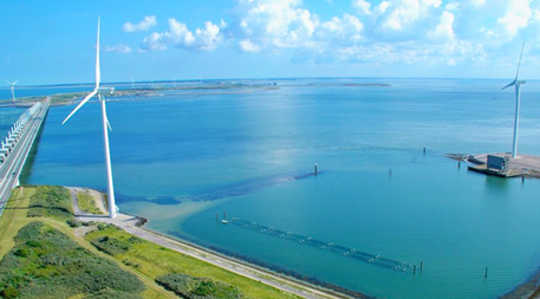 Zeewaar’s seaweed farm in the Eastern Schedlt National Park grows a winter crop of kombu and a summer crop of sea lettuce. Photo courtesy of Zeewaar
Zeewaar’s seaweed farm in the Eastern Schedlt National Park grows a winter crop of kombu and a summer crop of sea lettuce. Photo courtesy of Zeewaar
Seaweed is often seen as an environmentally friendly food source because requires no land to grow. Wild harvest raises some concerns because of its potential to harm underwater ecosystems. But the Dutch government conducted research suggesting that 400 square kilometers (nearly 100,000 acres) of seaweed fields could be farmed in the North Sea with no negative impact.
In November 2016, a letter to the Dutch House of Representatives co-written by then State Secretary for Economic Affairs Martijn van Dam said the government would build a new food policy that would promote healthy food, ensure greater sustainability and develop new protein sources such as seaweed.
Just a few months later, van Dam was on a boat harvesting The North Sea Farm Foundation’s first crop of seaweed off the coast of The Hague. He came on shore to attend a one-off “Extraordinary Seaweed” event marking the occasion, made a seaweed wrap and then announced the investment of €5 million into a new program titled Seaweed for Food and Feed, involving The North Sea Farm Foundation among other industry players and research institutions.
“Seaweed is the food of the future: sustainable and healthy,” van Dam was quoted as saying at the announcement. “With this ‘innovation program’ we will focus on new food products that are produced sustainably and are attractive to a wide audience.”
Sustainable Alternative
Sarah Redmond, a seaweed farmer with Springtide Seaweed in Maine, U.S., says that interest in seaweed aquaculture has been growing strongly in recent years, but the North American industry has yet to take off.
“The seaweed aquaculture industry is still new and developing, so there are very few processing operations in place to process the new crops into saleable items,” Redmond says. She notes, however, that seaweed has a stellar potential if marketed as a sustainable alternative to other ingredients.
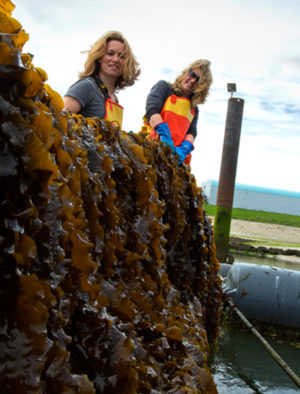 Zeewaar co-founders Jennifer Breaton and Rebecca Wiering harvest a crop of royal kombu. Photo courtesy of Zeewaar
Zeewaar co-founders Jennifer Breaton and Rebecca Wiering harvest a crop of royal kombu. Photo courtesy of Zeewaar
In the Netherlands, the Dutch seaweed distributor Seamore has used this approach to get its European Union–grown seaweed into over 500 stores in the Plus and Albert Heijn supermarket chains as of 2016. Its two main products, tagliatelle and seaweed bacon, are made from 100 percent organic, gluten free, non-GMO, vegan, low-carb seaweed.
Seamore’s approach has been to avoid unappetizing connotations of slimy weeds from the sea, and make their products a synonym for ingredients that consumers know and love. They then circumvent culinary confusion with a website packed full of videos, recipes and pictures, and encourage fans to send in their own creations.
“Of course, as with any innovation, educating consumers is a challenge that players will need to address,” says Seamore’s founder, Willem Sodderland.
Though one of the most successful Dutch seaweed businesses, Seamore actually sources its products from France and Ireland — still regional, but not quite local. The seaweed is also wild harvest. Sodderland says this was not desirable and due to a lack of supply and very high prices within the Netherlands for cultivated seaweed.
“Our vision is that ultimately almost all seaweed will be farmed,” he says.
Original Umami
Zeewaar is the first and only commercial Dutch seaweed farm and, according to co-founder Jennifer Breaton, the only certified organic seaweed farm in the whole EU. Though its product is more expensive than regional wild harvested seaweed, the company markets it to other businesses as an ingredient replacement with added sustainability — as well as good taste.
“Seaweed is the original umami,” says Breaton. “MSG was designed after the umami of seaweed. It’s a flavor enhancer. Dashi [Japanese stock] is all kelp.”
The pitch seems to have worked: Zeewaar has gotten its harvest into a surprising array of products, including salt, roasted peanuts, tea, chocolate and falafel balls. The roasted peanuts are sold by Hema, a major discount Dutch retailer, and the balls have found their way via Dutch food producer ProLaTerre into Ekoplaza, the largest organic supermarket chain in the Netherlands.
Flavor From the Sea
By far the most iconic of Dutch seaweed entrepreneurs, however, is The Dutch Weed Burger. The biggest customer of Zeewaar, it has turned the company’s two crops of royal kombu and sea lettuce into Weed Sauce (think mayonnaise), Sea Nuggets, Weed Dogs, Seawharmas and Weed Burgers.
“Just eating it raw? You have to be a hardcore lover of seaweed to do that,” says co-founder Mark Kulsdom. “But if you dose it nicely, you have the flavor from the sea without having a fish reference.”
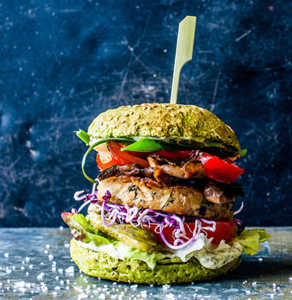 The Dutch Weed Burger aims to lure eaters to seaweed by adding an unfamiliar ingredient to a familiar product. Photo courtesy of Mark Kulsdom
The Dutch Weed Burger aims to lure eaters to seaweed by adding an unfamiliar ingredient to a familiar product. Photo courtesy of Mark Kulsdom
Kusldom has just returned from his production facility with a stock of 30,000 seaweed burger patties to see him through the summer. In addition to his eponymous restaurant and food truck, he says he stocks over 200 Dutch businesses, including all 74 cafes in the nationwide Bagels & Beans chain.
Much like Seamore and Zeewaar, Kulsdom says that a certain comfort factor is key to his success.
“Burgers are a way in, because you can introduce the flavor, but there’s still a lot of familiarity to the product,” he says. “[Customers] know the burger, they know the toppings, they know how it looks, how to hold it and how to eat it.”
And with an easy-to-understand product and a sly name, Kulsdom says his restaurant is bringing in customers for adventurous, novel eating — vegan and non-vegan alike. Unlike the raw green product spurned by the child when this article began, Kulsdom has made Dutch seaweed something that, after a long and unlikely journey, can be found in the hippest of restaurants in the heart of Amsterdam.
This article originally appeared on Ensia
About The Author
Joshua James Parfitt is an English journalist. Currently interning with environmental news source Mongabay, he will soon study for a diploma in multimedia journalism. He speaks five languages and has written in three continents about food, religion, environment, crafts and architecture.
Related Books
at InnerSelf Market and Amazon




















